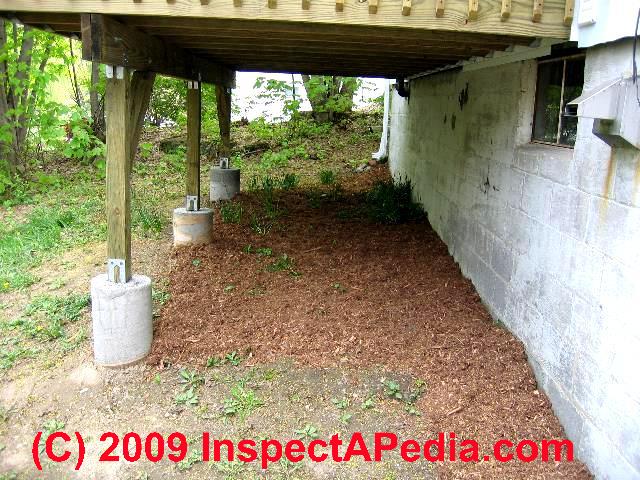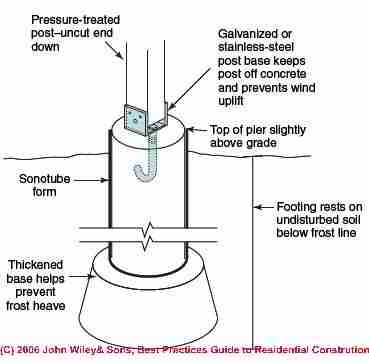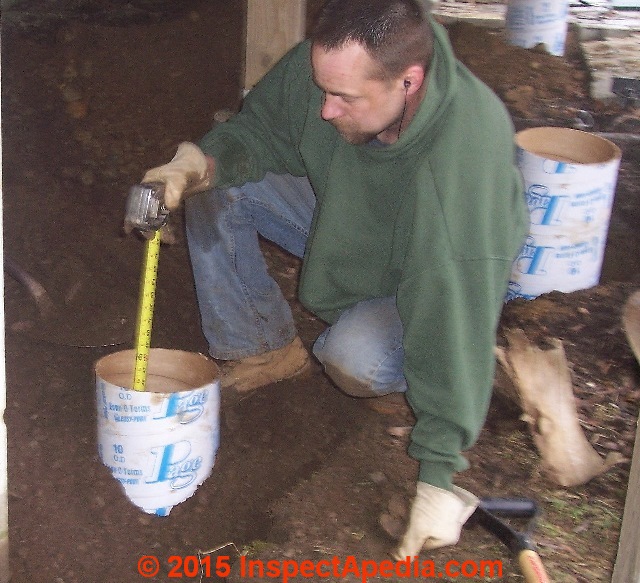 Concrete Mix for Deck Footings & Piers
Concrete Mix for Deck Footings & Piers
How to mix concrete in small batches or by hand
- POST a QUESTION or COMMENT about deck construction & mixing concrete for deck construction or building repairs
Concrete mixing procedure for home repairs, small projects, or design-build deck projects:
How to prepare concrete for deck footings & piers. This article tells how to mix your own concrete or how & when to decide to order a concrete delivery when building a deck, porch, or exterior stairs.
We describe mixing small amounts of concrete by hand, using power concrete mixers, and also using a power post or pier hold digger. The article includes advice when ordering concrete to be delivered to your deck project.
We also describe in detail mixing concrete by hand for small home repair jobs such as filling a hole in a basement floor slab. This article series describes construction details for decks and porches.
InspectAPedia tolerates no conflicts of interest. We have no relationship with advertisers, products, or services discussed at this website.
- Daniel Friedman, Publisher/Editor/Author - See WHO ARE WE?
DIY Small Concrete Projects
 Article Contents
Article Contents
Deck Footing & Pier Concrete Preparation
One of the major decisions you need to make early on is whether or not to mix your own concrete. The choice is largely dependent on the number and depth of piers and footings you need, as well as your budget and available time.
If you are not sure how to proceed, consider mixing the concrete yourself for one pier and footing, then decide if you can handle the effort for the others. Concrete can irritate your eyes, lungs, and skin, so it’s best to wear gloves, long sleeves and long pants, a dust mask, and eye protection when you work with it.
Watch out: Keep in mind that as soon as you add water to the dry mix, the clock starts ticking.
Have tools, materials, and helpers in place ahead of time, and mix concrete in batches small enough to finish your work before the concrete starts hardening (about 90 minutes in cool weather, 45 minutes—or less—in warm weather). If you use a power mixer, read the instructions before you turn it on.
How Much Concrete Do I Need per Form Tube?
Before buying bags of ready-mix concrete (just add water), or raw materials (portland cement, sand, gravel), or deciding to buy your concrete from a delivery truck, it makes sense to figure how much total concrete you need to fill all of your footing and pier forms.
You could calculate the cubic feet of concrete needed by using simple math for which we give detailed examples at STATIC HEAD. You just need the diameter of your form tubes and the length (or height) to which you're going to pour concrete.
Vcyl = pi x r2 x h
where pi = 3.1416,
r = the radius of the circle formed by the cylinder (the well shaft or casing), and is simply 1/2 of the well diameter
h = the height of the cylinder of water (the static head height that we measured above).
Watch out! be sure to write the radius and height in the same units of measure - here use inches.
But Sonotube® as well as other concrete form manufacturers kindly do the math for us as we show in the following table.[6][7]
How Much Concrete Do I Need Per Deck Pier or Sonotube?
Table of Quantity of Concrete Needed per Foot of Concrete Form Tube |
||||||
| Concrete Form Tube Diameter in Inches | ||||||
| Cubic feet of concrete per foot of form tube height | ||||||
| Number of 80-lb bags of concrete mix per foot | ||||||
| Number of 60-lb bags of concrete mix per foot | ||||||
| Number of 50-lb bags of concrete mix per foot | ||||||
| Number of 40-lb bags of concrete mix per foot | ||||||
Notes to the table above
- Data courtesy of Sonotube® for Builders Tube® concrete forms[6] and other sources.
- Sakrete offers an online building materials calculator that you can also use to determine concrete requirements, useful if you're mixing from scratch. See Sakrete Concrete Calculators [web page] provided by that company.
- Where we give two values in the table the data reflects the variation among concrete form tubes manufacturer's advice. In a practical sense it makes sense to round up to an even number of bags of ready-mix concrete when making your purchase.
Concrete buying tip:
Order enough concrete, including allowing for a small wastage, but do not over-buy your concrete unless you have another place to use it.
Dumping excess concrete out on to your yard and letting it harden is just the first step in disposal. You'll need to break up and dispose of any excess properly.
How to Mix Concrete by Hand
Concrete is a mix of Portland cement, sand, gravel, and water.
Fortunately, you can buy pre- mixed bags of the dry ingredients and add your own water. One 80-pound bag should yield about 0.6 cubic feet of mixed concrete. You will need a plastic mortar tub or wheelbarrow, a mortar hoe (a shovel or garden hoe can also be used), and a source of water.
A mortar tub is sturdier and less expensive; a wheelbarrow is easier to move around the site.
When you mix concrete, measure out the amount of water specified on the bag, but pour in only about 90 percent of it at first, then add small amounts as described below.
Avoid adding too much water. If the mixture becomes runny, with small pools of water forming on the surface, you will need to add another full bag of dry ingredients and more water.
Empty a small bag of dry, premixed concrete into your mortar into your mortar tub.
If you try to use only a partial bag, you may not pour out the properly balance mixture or ingredients. Mix the dry ingredients together, and then pour about 90% of the suggested amount of water into a small or crater in the middle. Pull dry ingredients into the water with the hoe, and mix carefully.
As you mix the concrete, add small amounts of water at a time, and mix each addition in thoroughly before adding more. When you can form a small pile of concrete that holds its shape, the mixture is ready to use.
Be careful not to add too much water; if you do, the mix will look wet, with pools forming on the surface. Adding a partial bag of dry mix to fix the problem is not recommended because the proportion may not be right.
Power hole diggers for deck pier / post holes
Power augers can remove dirt much faster than manual diggers. But that does not mean that they make the job easy.
Check local rental stores to see what kinds of tools they carry, and choose an auger bit that matches the width of hole you want to dig. Make sure to wear ear and eye protection when working with a power auger of any type. Two-person power augers like are quite common. They are best used by two relatively strong people who can maintain a firm grip on the handles at all times.
If you are working alone, a flexible-shaft auger is a good choice. It has an engine separated from the auger, rather than sitting on top of it, which makes it lighter and easier to handle. You may need a trailer hitch to tow one of these tools home. A more powerful one-person auger features an engine mounted on top of the auger; in this case, the operator stands on a small platform at the rear of the device.
This tool must be anchored to the ground with chains and spikes. Be sure to get thorough instructions for any rental tool before you try to operate it. Alternatively, you may prefer to hire someone with an auger mounted on a truck, tractor, or skid-steer loader.
Power Mixing Tools for DIY Concrete Jobs
A rented electric or gas-powered mixer can be used with premixed concrete, but you may find it more economical (if a bit more complicated) to mix your own dry ingredients.
Use a shovel to mix one part Portland cement, two parts sand, and three parts coarse gravel, and then slowly add water until you achieve the right consistency.
Turn off the power whenever you check the mixture. Some power mixers can be emptied right into the hole.
Concrete Delivery
If you need a large amount of concrete, your best option is to have it delivered in a commercial truck. Concrete is ordered in cubic yards (a cubic yard equals 27 cubic feet), so you will have to calculate how much you need very carefully before ordering.
Tell the supplier you are using the concrete for deck footings. When the truck arrives, you should have a couple of helpers ready to go to work immediately. You will probably need to unload concrete into wheelbarrows, which need to be emptied quickly into holes and refilled.
If you keep the truck waiting, you may incur extra charges and the concrete may harden.
When ordering or mixing concrete, you should know how much you need, and that requires some work with a calculator.
For estimating purposes, figure the size of a flared footing as though it were an equivalently sized cylinder.
To determine the amount of concrete in each footing and pier (or for any cylinder), first use the following formula: radius 2 x inches of depth x 3.14 = cubic inches. Then convert cubic inches to cubic feet.
How to Place the Concrete in the Forming Tube
- Cut the forming tube to required the length
(or purchase pre-cut lengths). In most applications you want the top of the poured concrete pier to be above ground level - offering better dry-out and protection for the post bottom.
But as our photos have illustrated, on a sloping ground rather than build very tall concrete piers above ground, we make up most of the difference in post height instead. It's reasonable to keep the concrete 6" above ground, and higher is fine especially with larger diameter and deep-set forms. - Dig a hole larger than the diameter of the form to be used. (Some manufacturers say twice the diameter of the form to be used.)
- Place the tube in the hole, and refill the space around the outside of the form tube to secure it's position. As you backfill, check that you are keeping the tube vertical (plumb) and then tamp your backfill so that the tube won't move.
- if tube extends two feet or more above the ground line you need additional support against tipping as the weight of the concrete may tip the tube even though you backfilled. In this instance make an additional support (wooden collar or frame and side braces).
- Fill the tube to the desired level with concrete.
- Rod the concrete to eliminate air.
Watch out: do not use a mechanical vibrator when removing air from concrete form tubes described here. - As the concrete begins to set remember to insert the bolt that will be used at each pier to connect the post anchor. If your measurements were close and the piers are properly located to ultimately locate the posts that will rest on them, then the bolt for the post anchor should be in the center of the pier.
- Leave the tubes alone to allow the concrete to set. Don't move them around before the concrete is cured.
Where to Buy & Mix Concrete By Hand for Small Jobs
We have moved this material to a separate article now found
at CONCRETE DIY SMALL JOB PROCEDURE
...
Continue reading at DECK PIER CONSTRUCTION or select a topic from the closely-related articles below, or see the complete ARTICLE INDEX.
Or see these
Recommended Articles
- CONCRETE DECK PIER PROCEDURE
- CONCRETE DIY SMALL JOB PROCEDURE
- CONCRETE DELIVERY & MIXING
- DECK & PORCH CONSTRUCTION - home
- DECK PIER CONSTRUCTION
Suggested citation for this web page
DECK PIER CONCRETE MIX at InspectApedia.com - online encyclopedia of building & environmental inspection, testing, diagnosis, repair, & problem prevention advice.
Or see this
INDEX to RELATED ARTICLES: ARTICLE INDEX to BUILDING DECKS & PORCHES
Or use the SEARCH BOX found below to Ask a Question or Search InspectApedia
Or see
INDEX to RELATED ARTICLES: ARTICLE INDEX to BUILDING STRUCTURES
Or use the SEARCH BOX found below to Ask a Question or Search InspectApedia
Ask a Question or Search InspectApedia
Try the search box just below, or if you prefer, post a question or comment in the Comments box below and we will respond promptly.
Search the InspectApedia website
Note: appearance of your Comment below may be delayed: if your comment contains an image, photograph, web link, or text that looks to the software as if it might be a web link, your posting will appear after it has been approved by a moderator. Apologies for the delay.
Only one image can be added per comment but you can post as many comments, and therefore images, as you like.
You will not receive a notification when a response to your question has been posted.
Please bookmark this page to make it easy for you to check back for our response.
IF above you see "Comment Form is loading comments..." then COMMENT BOX - countable.ca / bawkbox.com IS NOT WORKING.
In any case you are welcome to send an email directly to us at InspectApedia.com at editor@inspectApedia.com
We'll reply to you directly. Please help us help you by noting, in your email, the URL of the InspectApedia page where you wanted to comment.
Citations & References
In addition to any citations in the article above, a full list is available on request.
- [1] Steve Bliss's Building Advisor at buildingadvisor.com helps homeowners & contractors plan & complete successful building & remodeling projects: buying land, site work, building design, cost estimating, materials & components, & project management through complete construction. Email: info@buildingadvisor.com
Steven Bliss served as editorial director and co-publisher of The Journal of Light Construction for 16 years and previously as building technology editor for Progressive Builder and Solar Age magazines. He worked in the building trades as a carpenter and design/build contractor for more than ten years and holds a masters degree from the Harvard Graduate School of Education. Excerpts from his recent book, Best Practices Guide to Residential Construction, Wiley (November 18, 2005) ISBN-10: 0471648361, ISBN-13: 978-0471648369, appear throughout this website, with permission and courtesy of Wiley & Sons. Best Practices Guide is available from the publisher, J. Wiley & Sons, and also at Amazon.com - [2] Decks and Porches, the JLC Guide to, Best Practices for Outdoor Spaces, Steve Bliss (Editor), The Journal of Light Construction, Williston VT, 2010 ISBN 10: 1-928580-42-4, ISBN 13: 978-1-928580-42-3, available from Amazon.com
- [6] Sonotube, "Sonotube Builders Tube® Concete Forms", Sonoco, www.sonotube.com, Tel: 866-766-8823, retreived 4/30/2013, original source www.sonotube.com copy on file as Sonotube® Builders Tube® concrete forms.pdf
- [7] QuikCrete, Quik-Tubes No. 6922 INSTALLATION INSTYRUCIONS, The Quikrete® Companies, Inc., One Securities Cewntre, 3490 Piedmont Rd., Suite 1300, Atlanta GA 30305, Tel: 404-634-9100. Retrieved 4/30/2012 & 2024/06/24 copy on file as Quik-Tube-Instructions.pdf
Also see Quikrete's QUIK-TUBE PILLAR FOUNDATIONS instructions [PDF] - retrieved 2024/06/24, copy on file as Quik-Tube-Pillar-Instructions.pdf
Excerpt: QUIK-TUBE™ rigid fiber building forms are the ideal method of pouring cylinder-shaped concrete foundations for deck and porch supports and other loadbearing applications.
QUIK-TUBE™ forms can also be used to create attractive bases for lamp posts, fence posts, basketball net posts, mailbox posts and other postsetting applications.
Such forms may also be required by frost line building codes. - In addition to citations & references found in this article, see the research citations given at the end of the related articles found at our suggested
CONTINUE READING or RECOMMENDED ARTICLES.
- Carson, Dunlop & Associates Ltd., 120 Carlton Street Suite 407, Toronto ON M5A 4K2. Tel: (416) 964-9415 1-800-268-7070 Email: info@carsondunlop.com. Alan Carson is a past president of ASHI, the American Society of Home Inspectors.
Thanks to Alan Carson and Bob Dunlop, for permission for InspectAPedia to use text excerpts from The HOME REFERENCE BOOK - the Encyclopedia of Homes and to use illustrations from The ILLUSTRATED HOME .
Carson Dunlop Associates provides extensive home inspection education and report writing material. In gratitude we provide links to tsome Carson Dunlop Associates products and services.


